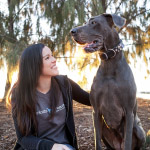Shooting a "Dogscape"
If you adore your dog but feel a little strange at the idea of having a big canvas of just them up on the wall in your living room (crazy dog person, anyone?) one alternative is to shoot what I like to refer to as a "dogscape". The primary focus of the shot will be on the landscape component, but making an appearance will be your dog. This can be a rather cool little addition to spice up your image in a meaningful way.

Location choice is the most important aspect of this style of image so location scouting is a must! Whatís possible in your local area of course depends where you live in the world and where youíre permitted to take dogs. If youíre coastal, beaches and oceanfront areas are fantastic as they often have clear views and excellent light, with dog friendly beaches becoming increasingly popular around the world.

Natural wilderness areas, forests, mountains, plains, rural and farming areas and the outback are all good options - just go for a drive out of the city and suburbs and see what you can find - the possibilities are endless if you allow some travel time.
Obviously youíll need to make sure the location allows dogs and if itís private property, get permission from the property owner beforehand.

Itís really helpful if your dog has a good solid stay command so you can position them where you want them in the shot. If not, you can work with them on-lead by tethering them to something nearby - a tree, fence post or a stake in the ground. Manage their energy and mood while theyíre tethered and make sure they look happy and relaxed - a stressed out, tethered dog is easy to spot in the finished photo.
Shooting with a wide angle lens generates an expansive view, with the dog as the main feature in the foreground. Experiment with composition by placing them off to the side, allowing more of the background to be visible.

Shooting from further back and zooming in with a longer focal length has the effect of compressing the perspective in the image which is a great technique to create background layers, making rolling hills or distance mountains appear closer.
The sky can also feature heavily - think dramatic cloudscapes, sunsets, rainbows and distant rainstorms.
Landscape photographers often shoot at high apertures to ensure all the features of the landscape are sharp from foreground to background. If you want the features of your landscape to be clear, consider creating more depth of field in your image by using a higher aperture setting.

Look to the landscape photography masters for inspiration. Find a style of shot you love and think about how to incorporate your canine subject in a similar shot. Consider how you can incorporate various layers in your image - foreground, middle ground and background.
For more dog photography inspiration, check out Charlotte's latest e-book. Entitled Dog Shots, it's a compendium of ideas, tips and tricks for dynamic and creative natural light dog photography. This recipe book of 30 fresh and fun ideas will help you spice up your dog photography through inspiration coupled with technical know-how. Focusing on utilising locations, working with light and obtaining expression from your subjects, itís a must-have field guide for any pet photographer at any level.
You can view more details and purchase the e-book at the Learn Pet Photography website.







